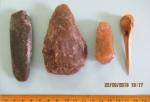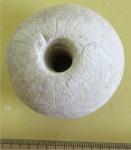Summary (English)
The planned excavation was to take place outside the grotto, but this was prevented by bad weather. Therefore, exploration took place in the area immediately behind what now seems certainly to have been the ancient entrance, hidden below several successive collapses.
The decision was made to only work in the interior where it was possible to carry on with some programmed interventions, although rainwater infiltration and excessive dripping meant the areas had to be carefully selected.Based on the results of the micro-morphological and palaeo-botanical analyses of the 2015 samples, which revealed a deposit of extraordinary anthracological wealth and diversity, all of the excavated soil was collected, and washed using a floatation machine with a 4/3/2 mm mesh, the stone residue then being sorted. The skeleton was weighed in order to evaluate the composition, granulometry and any variations within it.
A larger excavation area (1.60 × 2.50 m) was opened by the entrance with the aim of reaching the lowest level, thus creating a continuous section of the deposit and a sufficient surface area for sampling. In a small part of the deposit, the pre-ceramic level was reached which produced flint flakes and an equid tooth. The excavation was halted across the entire area at an extensive stony surface, which presented burial cuts, datable to the beginning of the Eneolthic period, as suggested by the presence of a so-called club/cleaver head of decorated limestone and a small vase (largely reconstructable) already attributed to that horizon.The numerous human remains, including at least thirteen teeth, although not articulated, accompanied by ornamental elements, such as a pierced pendant, numerous beads, and two small pearls, support this hypothesis. Also in this area, several holes were identified, two of which presented concretionary borders, perhaps used to house containers made of ceramic or perishable materials. In one case, the upper part of the container probably jutted out over the surface in which the hole was made. This indicates that the raised border of the concretion certainly formed after the hole was created.
This season’s excavations showed that the stratigraphic sequence crossed in this area post-dated the positioning of the large boulders close to the entrance, which seem to delimit specific areas and appeared to be in situ, also due to their dimensions.
The 2016 campaign also saw the continuation of the intervention towards the centre of the ‘camerone’, where numerous stratigraphic layers were uncovered, interpretable as the in situ residue of a disturbed burial. Several exceptional objects seem to belong to the grave, such as a chisel made from green stone of probable Alpine provenance, a hatchet and another tool, both made of flint using the Campignian technique.
Lastly, the upper levels produced numerous finds including the wall of a painted terracotta vase with a vertical strap handle, attributable to the Scaloria Alta facies.At this stage of the research, the general impression is that this area of the cavern was probably a funerary context, considering the fact that the human bone does not seem to be duplicated and can therefore be attributed to a single individual, even though the burial context is badly disturbed, with part of the skeleton missing and the distribution of the other remains over a fairly wide area, as if the burial had been subject to erosion and, in some way dragging.
The investigation in the Occhiopinto branch of the cavern, aimed at making a complete survey of the underground complex, concentrated on a series of large holes noted by the Archeo-Speleological Group of Manfredonia in the so-called Camera del Guano now partially cleared of bird excrement.
Cut into the bedrock, the holes presented characteristics that were particularly interesting both for morphology and for their position. These man-made holes were sub-oval and average dimensions of between 35-50 cm in length and 25-35 cm wide, and arranged in more or less parallel rows. The rock bank in which they were cut appeared as a sloped surface with the holes arranged in correspondence with the areas with the greatest amount of dripping and in such a way that the overflow from the upper rows flowed into the holes immediately below, thus maximising water collection and limiting its dispersion.
Director
- Eugenia Isetti- Istituto Italiano per l’Archeologia Sperimentale-Genova
Team
- John Robb - Università di Cambridge
- Antonella Traverso – Polo Museale della Liguria
- Donatella Pian - Istituto Italiano per l’Archeologia Sperimentale-Genova
- Guido Rossi- Museo di Archeologia Ligure Genova
- Stefano Nicolini
- Erica Ceccarelli
- Ivano Rellini – DISTAV Università degli Studi di Genova
Research Body
- Istituto Italiano per l’Archeologia Sperimentale-Genova






![Download [PDF]](/excavation/skins/fasti/images/results/download_sml.png)
